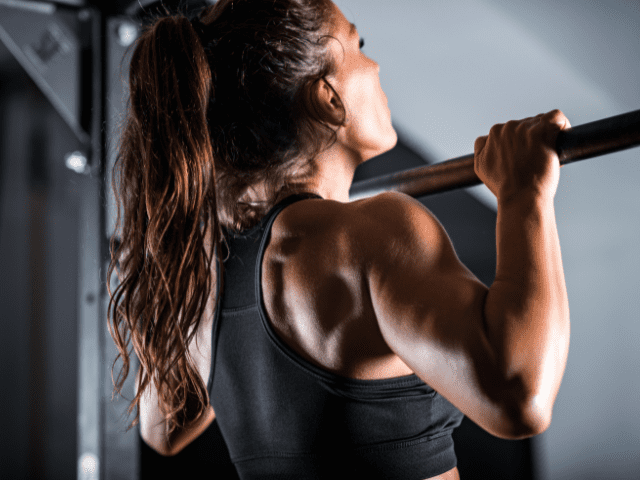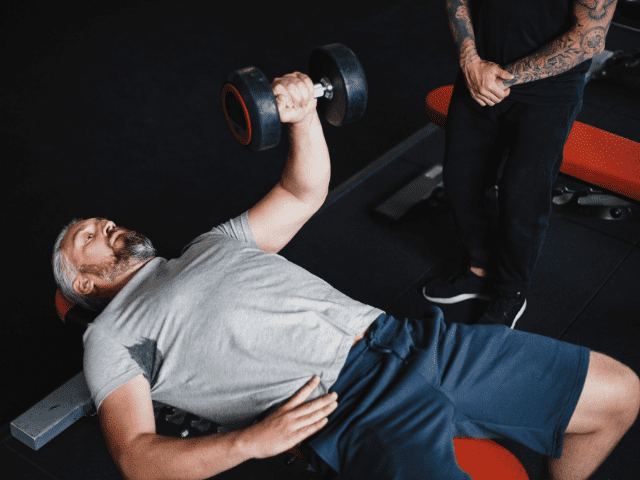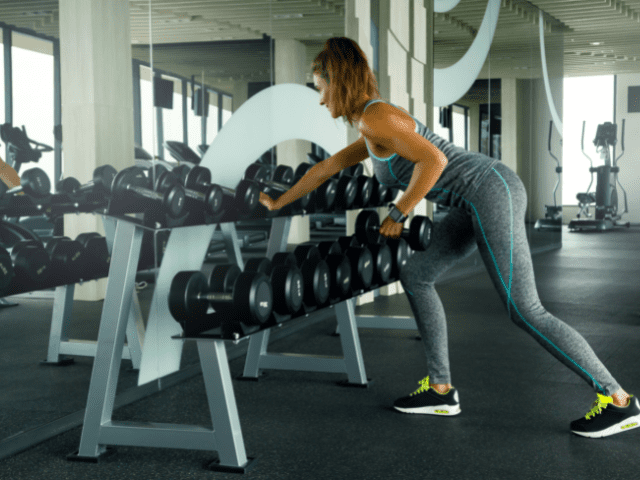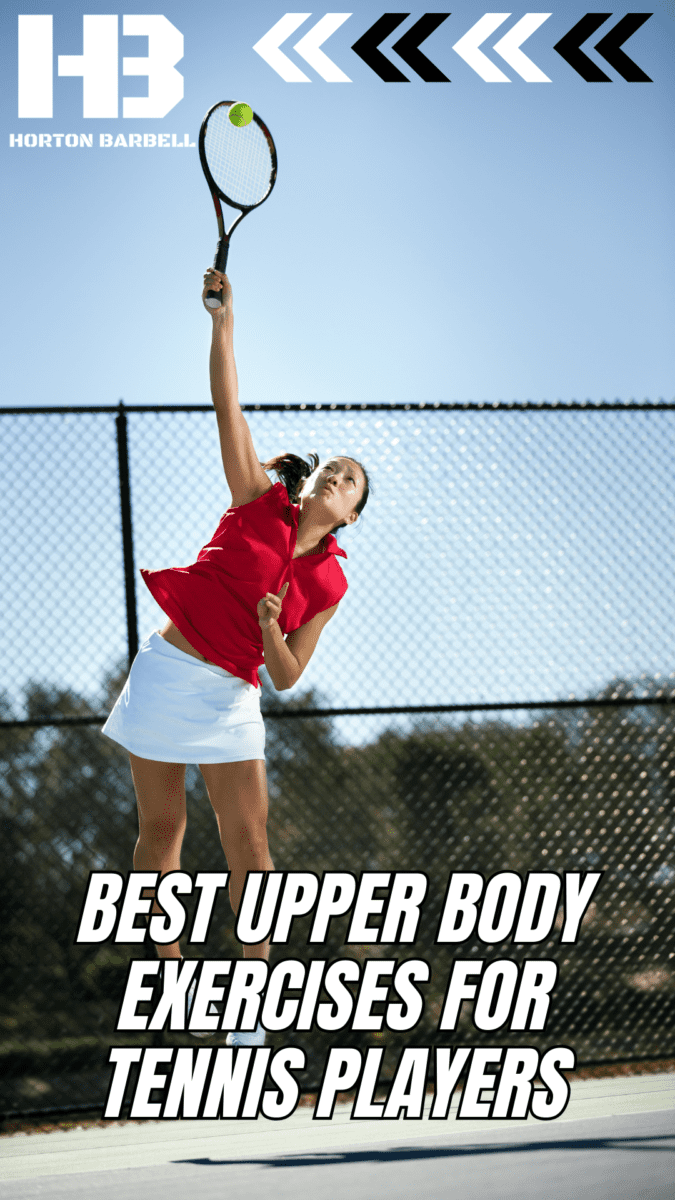The 7 Best Upper Body Exercises For Tennis Players
Having a strong and powerful upper body is essential for tennis players. Having a powerful upper body will help you hit harder serves and cross-court shots harder and put pressure on the opponent. Intelligent upper-body training will also help tennis players be resilient to injury.
You need to consider your shoulders, elbows, and wrists in every movement that you perform. Upper body training is not about getting jacked and pumped up like a bodybuilder. Training the upper body for tennis is all about functionality, sport-specific, low risk-to-reward ratio movements, that will directly carry over to the court.
To gain strength in the upper body, I think the best implements are barbells, dumbbells, and kettlebells. These implements will engage the most musculature and can be trained and overloaded over time. Never sacrifice your form for weight!
You are not going to see a lot of bodybuilding or bicep and tricep exercises here. Compound movements train these muscles naturally anyways.
I recommend these movements in the early off-season, fall season, winter, and in-season training regimen. How heavy, how often, and what exercises you are using are determined by the game schedule and your training readiness.
In this article, I will be going over the 7 best upper body exercises for tennis players to help you stay healthy and hit harder shots!
Upper Body Exercises For Tennis
Weighted Push-Ups
The Weighted Push-Up is one of the best movements a tennis player can master. I love the weighted push-up for tennis players because it is a horizontal push, that can be overloaded, and is very shoulder-friendly.
Load this movement with bumper or iron plates along the midback (Chains work well too if you have some). Because the scapula is free to move, you will find the weighted push-up to be very shoulder-friendly. Remember to go slow in your progression.
Step-by-Step Instruction
- Lie face down on the floor.
- Have a partner place the implement of resistance on your mid-back. Do not put the implement too high or too low.
- Pull your toes in so that you’re on the tip of your shoes.
- Eyes should be focused straight down or slightly up.
- Pull your hands close to about the nipple line of the chest and bring them out about 2-3 inches away.
- Take a deep breath, engage the core and brace.
- Push yourself up in one unit. There should be no sagging of the waist. The entire body from head to toe should move up and then back down in unison.
- Feel your scapula upwardly rotate and make sure the antagonist muscles (Back and biceps) are fully engaging.
- Lock out your push-up and pause.
- Slowly lower yourself back down and get ready for the next repetition from just above the ground. Do not fully relax at the bottom of the push-up unless your program specifies.
Coaching Points
Be mindful of where you put your weight. If you put it too high, you may inhibit good scapula movement. If you put it too low, you may cause your low back to sag and the core to disengage.
Keep the elbows at a 45-degree angle. For maximal chest, shoulder, and rotator cuff engagement, do not let the elbows flare out away from the middle. Also, do not let the elbow hug right next to the torso.
Pull Ups

A strong posterior chain is essential for shoulder health and upper body strength. The Pull-Up trains this posterior chain (Lats, upper back, rear delt, rotator cuff) to be strong and resilient. Another added benefit of the pull-up is core and lower back stabilization.
A full range of motion in your pull-ups is critical for success here. I like to progress athletes into pull-ups. We initially will start with an eccentric phase, followed by an isometric, and finally a concentric one. I sometimes have athletes use bands to help with their pull-ups initially.
If you’re not ready for the pull-up, don’t worry! You can start with inverted rows and lat pull downs to gain strength. I also recommend straight arm hanging and isometric holds with your chin over the bar. These are great alternatives that will help you in the pull-up progression.
I typically program pull-ups in the early off-season and winter programs. I avoid most heavy overhead movements during the fall season and in-season training regiments due to the high load on the shoulder and elbow with multiple competitions per week.
Step-by-Step Instruction
- Approach the pull-up bar and grab the bar with a pronated grip (palms facing away).
- Use a bench to get to the bar if it is too high.
- Later in the article, I will talk about variations, alternatives, and modifications where the supinated (palms facing in) grip will be discussed.
- Squeeze the bar and engage the core muscles and do not cross your legs.
- Engage the upper back and pull up until your chin is over the bar.
- Pause for 1 second with your chin over the bar.
- Slowly lower yourself back to the starting position.
Coaching Points
Take your time and master the pull-up. The benefits of doing sound pull-ups will pay dividends for your shoulder health and the potential to maximize your upper body strength.
Single-Arm Dumbbell Bench

One of my favorite horizontal pressing movements, the Single-Arm Dumbbell Bench Press is a great option for tennis players. This pressing movement is great because it can be overloaded, trains single-arm strength (sport specific), and is extremely joint friendly.
Step-by-Step Instruction
- Grab your dumbbell, sit on the edge of the bench, and sit the dumbbell on your thigh vertically.
- Take a deep breath, lie flat on your back on the bench, and get your dumbbell in position ready to press.
- Lay your free hand on your stomach. Placing your hand on your hip (as shown in the featured image above) will help balance you more is a more beginner-friendly hand placement.
- Keep your feet flat on the floor.
- Keep your butt on the bench.
- Pull your shoulder blades together and keep the back of your head on the bench. You will slightly arch your back. Keep your core tight and keep the shoulder blades pulled back tight.
- The dumbbells should be slightly angled at roughly a 45-degree angle to the torso. (representative of the path you are descending with your elbows).
- Press the dumbbell up.
- Control the dumbbell down during the eccentric movement and draw the dumbbell in, keeping the elbow at that 45-degree angle from the torso.
- The dumbbell will make contact with your torso right at the nipple line on the chest.
- Once contact is made, drive the dumbbell back up.
- Complete the designated number of reps and then switch sides.
Coaching Points
If you’re familiar with Dumbbell Bench Press but are new to this single arm variation, you’ll probably be pretty surprised by just how much you need to brace your core to keep from literally rotating off the bench. For this reason, start light and then work your way up in weight.
Inverted Row (Multi-grip bar with neutral grip option)

The Inverted Row is a staple movement in any healthy training regimen for a tennis player. Specifically utilizing the multi-grip bar with a neutral grip option. I think this is most ideal for tennis players because this would be the identical grip they use with the racket.
Even without this specific barbell, a regular inverted row is tremendously beneficial as it trains the posterior chain, core stability, and grip strength. These are all sport specific, will help enhance performance, and mitigate injuries.
Step-by-Step Instructions
- Start by placing a bar on the rack about waist height.
- The higher the bar is placed, the easier the rows will be. The lower the bar is placed, the harder the rows will be. (Just make sure to leave yourself enough room to fully extend your arms at the bottom of the rep)
- Set the bar on either the J-Hooks or the Safety Bars
- Lay down underneath the bar.
- Grab the bar with an overhand grip, brace the core and make sure your body is fully extended – including your legs.
- You should be positioned to where when you pull yourself up towards the bar, the bar touches the same spot on the chest as it would for bench press. Slide up or down to adjust accordingly.
- Now, keeping your body in a straight line, pull your chest up to the bar and lower back down until your arms are fully extended.
- Repeat until all reps are completed.
Coaching Points
Athletes I coach love to either pull their face to the bar or even raise their chin up and over the bar like a pull-up. These are both wrong.
You should think of the Inverted Row like a reverse bench press. Keep your head back, chest out and pull your chest directly to the bar. Pull the shoulder blades down and back at the top of the rep and squeeze the back.
Single-Arm Dumbbell Overhead Press
Single-arm overhead strength is critical to the success of a competitive tennis player. On the court, we spend a lot of time serving and returning shots with our hands over shoulder height. Therefore, being strong overhead is critical to enhanced performance and resisting injury.
You can execute this exercise seated on a bench, on the ground, half kneeling, tall kneeling, or standing. All of these options are great and can be progressed within a program. Focus on core stability, neutral grip palms facing in, and finishing with a great overhead position with the bicep near the ear.
Step-by-Step Instruction
- Stand with the dumbbell next to you.
- Hinge at the waist and bend the knees until you can grab the dumbbell.
- Keep a neutral spine, and a nice flat back, and lift the dumbbell into your pressing position.
- I recommend palms facing away or toward you (whichever feels more comfortable).
- Brace the abdominal muscles and engage the upper back.
- Press the dumbbell directly overhead. (The dumbbell should not track forward.)
- Lock the reps out and pause for a quick second with each repetition.
- Slowly lower the dumbbell back to the starting position to prepare for the next repetition.
- Once all reps are completed on one arm, switch to the opposite arm and repeat.
Coaching Points
Keep the core engaged as you press. If you feel you are arching your back as you reach closer to lockout, consider going down in weight.
Remember this is not a push press. This is purely an upper-body pressing movement. If you are using your legs, even slightly, this would be called a Push Press. The push press is a great movement as well BUT a shoulder press should be focused on the shoulders, no cheating.
One Arm Dumbbell Row

A classic horizontal row that I love for tennis players, is the One Arm Dumbbell Row. This is a great rowing variation for single-arm training.
An awesome benefit of this variation is the non-rowing shoulder needs to stabilize as the other performs the row. Because your positioning is perpendicular to the floor, you are also training cross-body tension, engaging that core, and resisting rotation.
We know anti-rotation in the gym will aid in our ability to display rotational power on the court, so this is a great movement to train often!
Step-by-Step Instructions
- Grab a dumbbell and a bench*.
- Place the dumbbell next to the bench and set yourself up.
- If rowing with the right arm, place the left knee and left hand on the bench. Keep the right foot flat on the ground.
- Make sure the back is flat (neutral) to slightly arched.
- Brace the core and pick the dumbbell up.
- Row the dumbbell up, keeping the elbow close to the body as the dumbbell raises.
- Squeeze the back at the top of the rep and then lower the dumbbell down until the arm is fully extended.
- Repeat for the designated number of reps and then switch sides.
*One Arm Rows do not have to be done with one knee on a bench. You can keep both feet flat on the ground and lean forward and brace yourself with your off-hand on something sturdy. You can even lean your off forearm on your leg for support if necessary.
Coaching Points
The most common mistake I see athletes make when doing One Arm Rows is not maintaining a flat back. The back should stay engaged and slightly arched – similar to the starting position of a Power Clean. Do not let the back round as this can cause unnecessary stress on the spine.
Single Arm Farmer’s Walk
Grip strength has been correlated with health and longevity. The 1-arm farmer’s walk trains grip, core stability, and upper body stability. This is a unique and surprisingly challenging exercise that tennis players can benefit from.
Grab a dumbbell or kettlebell (start light and focus on posture before going heavy). Hold it at your side and with the none holding hand, place it on your side, and pull the shoulder blades back. Focus on crushing the dumbbell with your grip, squeezing the core, and keeping great posture.
How To
- Grab a single kettlebell or dumbbell.
- Brace the core and begin walking in a slow, controlled manner.
- As you walk, focus on keeping the core braced and the shoulders and hips square and level.
- Once you cover the assigned distance (or time), switch hands and repeat on the opposite side.
Coaching Points
You do not need to grab the heaviest kettlebell you can find. Find a weight that you can walk with and maintain proper form.
Don’t rush through. Single Arm Farmer’s Walk can be done for time or for distance. If going for distance, it should not be a speed walk to cover the ground as fast as possible. Stay under control and focus on form.
Final Thoughts
Intelligent upper body training is essential for tennis players. Getting strong with basic movements like push-ups and pull-ups will only benefit your health and performance. Utilizing barbells, dumbbells, and kettlebells to overload your upper body work is great as well.
Balancing pushing and pulling movements is important. In general, for every 1 push repetition programmed, I would aim to have 3 pulling repetitions programmed.
Remember why you are training. Everything you do should have some type of carry-over to your sport. Training with a specific purpose will always help you stay motivated and train hard consistently over time.
Focus on proper form, progressive overload, and continue to work hard on the court and you will see your results pay off!
If you found this article helpful, make sure to check out my favorite core and upper-body exercises for tennis as well!


